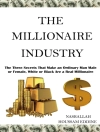In this unique, well-illustrated book, readers learn how fifty financial corporations came to dominate the U.S. banking system and their impact on the nation’s political, social, and economic growth. A story that spans more than two centuries of war, crisis, and opportunity, this account reminds readers that American banking was never a fixed enterprise but has evolved in tandem with the country.
More than 225 years have passed since Alexander Hamilton created one of the nation’s first commercial banks. Over time, these institutions have changed hands, names, and locations, reflecting a wave of mergers, acquisitions, and other restructuring efforts that echo changes in American finance. Some names, such as Bank of America and Wells Fargo, will be familiar to readers. The origins of others, including Zions Bancorporation, founded by Brigham Young and owned by the Mormon Church until 1960, are surprising. Exploring why some banks failed and others thrived, this book wonders, in light of the 2008 financial crisis, whether recent consolidations have reached or even exceeded economically rational limits. A key text for navigating the complex terrain of American finance, this volume draws a fascinating family tree for projecting the financial future of a nation.
Tabela de Conteúdo
Foreword, by Charles M. Royce
Overview of the Big 50
Introduction: A Brief History of Banking in America
Banks, Holding Companies and Corporate Genealogies: Necessary Technical Talk
The Big 50
Ally Financial
American Express
American International Group
Banc West
Bank of America
Bank of New York Mellon
BB&T
BBVA Compass Bancshares
BMO Financial
BOK Financial
Capital One Financial
Charles Schwab
CIT Group
Citigroup
City National
Comerica
Deutsche Bank
Discover Financial
E*Trade
Fifth Third Bancorp
First Niagara
General Electric Capital
Goldman Sachs
HSBC North America
Hudson City Bancorp
Huntington Bancshares
John Deere Capital
JPMorgan Chase
Key Corp
M&T Bank
Morgan Stanley
New York Community Bancorp
Northern Trust
People’s United Financial
PNC Financial Services
Popular
Principal Financial Group
RBS-Citizens Financial
Regions Financial
Santander Holdings USA
State Street
Sun Trust Banks
Synovus Financial
TD Bank US Holding
U.S. Bancorp
Union Ban Cal
USAA
Utrecht-America Holdings
Wells Fargo
Zions Bancorporation
Conclusion
Illustration Credits
Index
Acknowledgments
Sobre o autor
The Museum of American Finance, an affiliate of the Smithsonian Institution, is the nation’s only independent museum dedicated to preserving, exhibiting, and teaching American finance and financial history. With its extensive collection of financial documents and objects, and its seminars, events, educational programming and publications, the museum portrays the breadth and richness of American financial history, achievement, and practices. The museum is located in a historic bank building at 48 Wall Street, on the corner of William Street, in New York City. For more information visit www.moaf.org.Robert E. Wright became the inaugural Nef Family Chair of Political Economy at Augustana College in Sioux Falls, South Dakota, after teaching at New York University, the University of Virginia, and elsewhere. He is the author, coauthor, editor, or coeditor of more than twenty major scholarly books and projects related to U.S. financial and policy history.Richard Sylla is the Henry Kaufman Professor of the History of Financial Institutions and Markets and Professor of Economics at New York University. He is also Chairman of the Board of Trustees at the Museum of American Finance and a research associate of the National Bureau of Economic Research.Charles M. Royce is known as one of the pioneers of small-cap investing. He has been CEO of The Royce Funds since 1972. He currently serves as trustee of the Frick Collection, the New-York Historical Society, and the National Trust for Historic Preservation.












